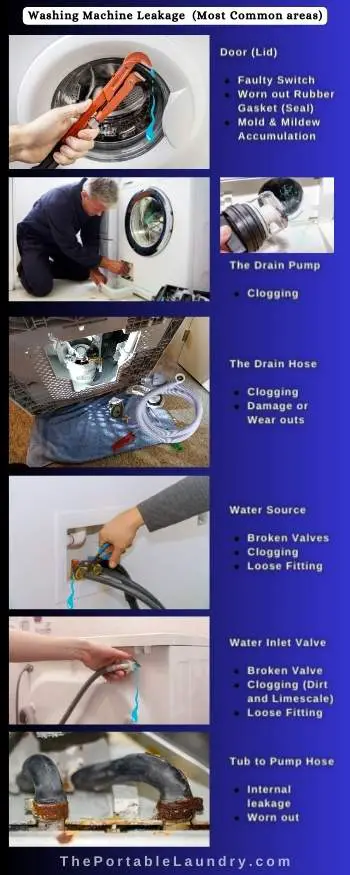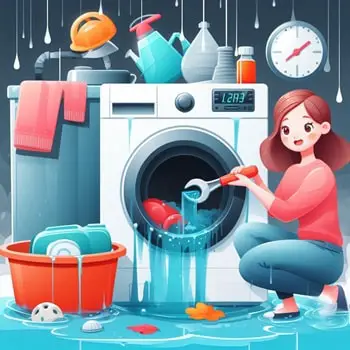| Problem Areas | Possible Solution |
| Water Inlet Valve | 1.) Tighten the loose hose connections and check if the threadings are not bad. 2.) Replace cracked valves or hoses. |
| Water Pressure Switch | 1.) Check for clogging in the water level tube and if its clogged try to unclog it. 2.) Seek expert advice if the pressure switch is faulty. |
| Gasket Cover (Front Loader) | Repair or replace a damaged rubber seal. |
| Door Lid (Top Loader) | 1.) Use the right amount of detergent and water. 2.) Ensure the door closes properly. |
| Clogged Drain | 1.) Clean the drain hoses and valves. 2.) Regularly inspect the sewage area. |
| Broken Drain Hose | Replace the damaged drain hose. |
| Drain Hose Clamps | 1.) Tighten lthe oose hose clamps and see if it properly locked. 2.) Replace damaged clamps, drainpipe, or hose. |
| Worn Out Drum | 1.) Seek expert assistance. 2.) Consider replacing the drum or pump if necessary. |
| Newly Installed Washer | Call a plumber or expert to identify and fix any issues. |
No matter what device you use, wherever water is used, the leakage problem will always be there and it will surely be the point of discussion.
A Washing Machine may leak from various parts such as the door gasket or the lid, the drain hose, water inlet hose, water supply valves, broken washtub, etc.
In order to fix the leakage issue, you need to first identify the area from where the water is leaking.
Water leakages need to be fixed at the earliest to avoid and prevent any further damage to your washer.
With this topic, we will cover the common grounds of leakage along with the solution to fix the same.
You will learn:
- Causes and solutions for a leaking washer
- Tips to avoid leakage
- Commonly Asked Questions
- And More…
Let’s dive right into it.
Causes and solutions for a leaking washer

Here are some common causes or reasons why your washer may be leaking along with possible solutions.
Water inlet valve
The water inlet valve is responsible to let the water through the washer from the water supplies.
There are usually 2 water inlet hoses attached for hot and cold water supplies.
There is a possibility of a loosened hose attached to the supply valves, in such instances, you may check the connectivity right from the point where the water is supplied through the hose towards the washer’s inlet valves.
Solution: If the valve’s connectivity is loose from either end, you may fix the issue by simply constricting the valves.
If you notice a crack on the valves or the hoses, you may consider replacing these parts.
Water pressure switch
Usually, washers have a water pressure switch that controls the water flow for specific cycles. Whenever water is needed the pressure controller allows the water to flow to the washtub.
A non-functional pressure switch may lead to an overflowing washer.
Solution: You may check for any clogs in the water level tube and clean them off. If the water pressure switch has an issue you need to seek a piece of advice from an expert.
Gasket cover (Front Loader)
In a front loader, there is a rubber seal surrounding the door gasket from the inside to avoid any leakage.
A damaged rubber seal will surely cause the washer to leak.
If the leakage is from the front door, there are high chances that either the rubber seal has been ripped or must have come off the door gasket, thereby causing the leakage problem.
Solution: If the rubber seal has a mild tear then you may use rubber tapes as a temporary fix, otherwise replacing the rubber seal would be a better solution.
Door lid (Top Loader)
The top-load washer’s door (lid) is located at the top and there is always a possibility of leakage during the spin cycle.
This may happen if excessive detergent is used, which further generates a lot of suds.
Another reason could that you are using a lot of water.
Using water more than the washer’s limit may cause water leakage from the corners of the door.
Solution: Use only the required amount of detergents along with the appropriate quantity of water. Moreover, check if the door closes properly. A lot of time the door alignment may get damaged due to excessive wear and tear.
Clogged Drain
A clogged drain may cause leakage through the hose valves and needs immediate attention.
There are many reasons why a drain may be cogged and the most common factors are lint accumulation, detergent & dirt residues, grease, oils, etc.
Note: At times clogged sewage may give you an impression of a clogged drain. Therefore it is important to inspect the sewage areas first before troubleshooting a clogged drain.
Solution: Detach and clean the drain hoses and valves with cleaning solutions. As a best practice, it is ideal for cleaning the drain along with the sewage area at least once a month.
Broken Drain Hose
A broken or cracked drain hose leads to water leakage from the bottom of the washer.
It is typical for a drain hose to get damaged or wear out and it is the most commonly replaced part.
Solution: A broken or a cracked hose should be replaced, this can be done easily, you just need to loosen the hose clamps to detach the hose and fix the new hose.
Drain Hose Clamps
Hose clamps are used to tighten the drain hose.
A loose or broken hose clamp may result in water leaking out from the connected area.
Solution: Inspect the drain hose connection and tighten the hose clamp if it appears to be loose, and this may fix the leakage. On the other hand, if you notice a crack anywhere on the clamp, drainpipe, or the hose then replacing the damaged part is the only solution.
Worn out Drum
Loose connectivity between the wash drum and the pump may cause leakage from the bottom of the washer.
Wash Drum is one of the most overworked parts of the washer and is prone to wear and tear.
Solution: DIY solutions can be tricky in such situations, therefore it requires an expert to diagnose and fix the root cause. At times the entire drum or the pump may need to be replaced.
Newly installed washer
If you have a newly installed washer then definitely there must be something to do with the fittings and the supplies towards the drain hose.
Solution: Immediately call a plumber or an expert to identify the cause and notify the manufacturer before offering any fix. This is because if you try fixing yourself, there are chances of voiding the warranty of your washer.
Tips to avoid leakage problems in Washing Machine

Now that you know the causes and solutions to fix a leaking washing machine, let us take a quick look at some easy tips to avoid the leakage in the first place.
- Avoid overloading the washer in any specific cycle as it puts a lot of stress on the motor and drum.
- Regularly inspect the water inlet and the drain areas including sewage for any possible blockage.
- Regularly clean the rubber seals of the gasket door in a front loader and the door lid areas of the top loaders.
- Do not insert or remove clothes harshly from the washer as they may damage the door or the rubber seals around them, especially the clothes that have a zip attached.
- Check your clothes and the pockets to make sure hard objects do not enter the washer which may cause blockage and amplify the wear and tear to your fabrics as well as the washer.
- Do not overuse cleaning solutions OR vinegar and baking soda to clean the washer.
Final Thoughts
Leakages can cause severe damage to your washing machine, hence regular inspection of commonly leaking areas is always a good practice.
Appropriate use of your washer will not only prevent leakage but also prolong the lifespan of the machine.
You may try to fix the few leakage problems at home for causes that are straightforward.
But for issues that you aren’t sure about, you should always approach an expert to avoid any mishap.
Frequently asked questions
Let’s take a quick look at the few frequently asked questions on the topic
Why is my washing machine leaking from the bottom?
Different types of washers may have different reasons for leakages from the bottom. The most common cause of leaking from the bottom is a cracked or clogged drain hose. A clogged drain hose can be cleaned by detaching and cleaning with the help of cleaning solutions with hot water. A broken or cracked hose should be replaced immediately to avoid leakages from the bottom of the washer.
Another factor of leakage from the bottom could be a damaged water pump and you need to get it fixed by an expert.
Is it worth fixing a leaking washing machine?
A minor leakage may lead to severe damage to your washer. Hence identifying the leakage source and fixing them is highly recommended. If your washer is old enough and the cost of repairing the leakage is close to half the value of your washer, then it may not be worth repairing the washer and you may opt for a replacement.
Can overloading a washing machine cause a leak?
Overloading the washer can affect the leveling or the balancing of the wash drum due to immense pressure. This further damages the tub bearings and may result in a broken drum. A broken drum will eventually lead to leakage and may involve high fixing costs.
Overloading may also cause leakage from the lid of the top loaders, this may occur when the washing spins at high RPMs.
Can a blocked filter cause a washing machine to leak?
Yes, a blocked filter can cause leakage as it blocks the flow of the water, hence cleaning the filter at regular intervals is highly recommended.




